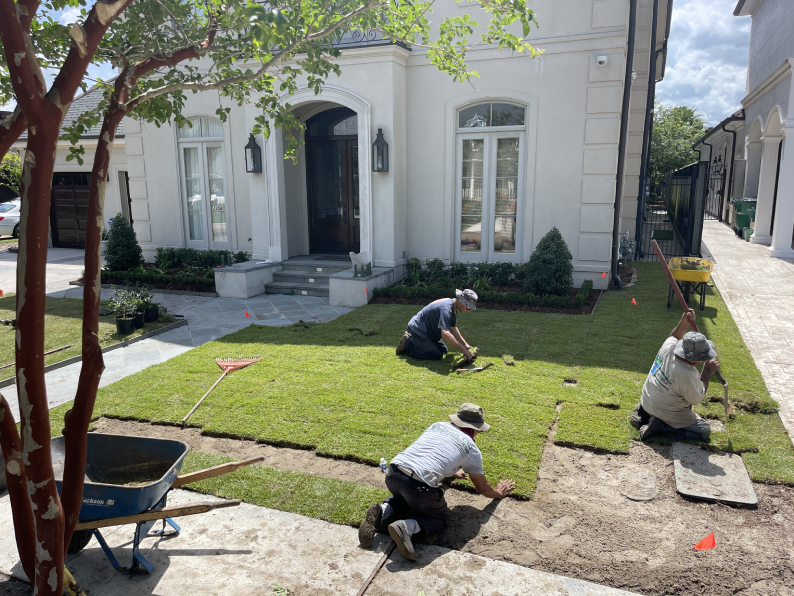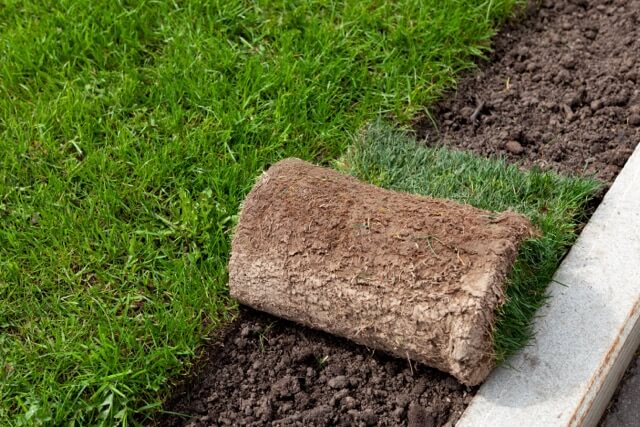Ah, sod. It’s a great way to transform and beautify your lawn and make it the envy of your neighborhood. But before you start investing in sod, you must make sure you get the right type. There are lots of brands, varieties, and types of sod out there to choose from to best suit your needs and budget. This guide will help you determine the right type of sod so that you get the most value for your money and keep your lawn in tip-top condition. Let’s jump into the step-by-step process for selecting the perfect sod and getting your lawn looking great.

Knowing Your Site Location and Climate
When it comes to selecting the right type of sod for your lawn, an important factor to consider is the location and climate. While some kinds of grasses may be suitable for one region, they could be unsuitable for another. It’s important to research and consult local experts to find which type of grass will do best in your area’s climate. If you live in an area with a cooler climate, then sod varieties such as fescue and perennial ryegrass are ideal options. On the other hand, if you live in a warmer climate, then Bermuda grass is a popular choice due to its heat tolerance and drought resistance.
There are also some tougher decisions that you must make when deciding what type of grass is appropriate for your lawn. For example, if you live in a hot and humid climate, it can help to choose a variety of sod that can survive under those conditions but also requires less watering than others. Choosing this type of sod can save you money on excessive water bills while still maintaining the health of your lawn.
Once again, it’s important that careful consideration goes into choosing the right type of sod for your lawn. It’s always wise to research different varieties and climates prior to making any final decisions so you can reap the benefits of having a beautiful lawn all year round.
Size and Amount of Land
Once you have factored in the site location and climate, it is essential to consider the size and amount of land that needs to be fitted with sod. When determining the amount of sod to buy, measure the area of the lawn in square yards and multiply by 220 for a general estimate on how many yards of sod would be required for the job.
In terms of size, buying large pieces will have more coverage but could cost more than buying smaller pieces. Furthermore, if there are irregular shapes to be covered, small pieces will be far easier to handle than large, rolled ones. It is important to first make sure your calculations are correct before purchasing any sod. Sometimes choosing the right-sized pieces can mean putting in some elbow grease, but it will be worth it in the end.
As you decide on the most suitable size for your sod needs, remember to factor in any backyard features such as garden beds and pathways that need specific care when laying down your turf. At this point, it is wise to determine what kind of landscape material such as bricks or gravel best suits these areas before finalizing your purchase.
Sunlight and Drainage Conditions
When it comes to sun exposure and drainage conditions, these variables should be carefully considered before purchasing sod. If you have been dealing with a particularly shady spot in your yard that never dries out, then it may not be the best place to install a new grass patch. On the other hand, if there is direct sun and good drainage overall, you may want to opt for a warm season grass variety that has proven to thrive in hotter temperatures.
It is important to analyze the total amount of sunlight and drainage in any given area when deciding which type of turfgrass would work best for you. For example, if your lawn is mostly shaded but has some patches that do receive direct sunlight, then choosing a mix of different grass species may increase your chances of having resilient grass capable of surviving those specific conditions. Similarly, if you find an area that receives light all day but the drainage there is not ideal, then selecting grass that can tolerate wet soil will be crucial.
The key thing to remember is that every lawn is unique, so it is worthwhile to look into the sun exposure and drainage conditions as well as local climate when making this decision. Taking such factors into account can prove beneficial in selecting the right type of sod for your lawn.
Researching Turfgrass Types
Now that you’ve assessed the sunlight and drainage conditions of your lawn, it’s time to research the different turfgrass types. The best way to start this process is by consulting with local landscapers, nurseries, or other lawn care professionals. Talking to an expert can help narrow down the types of sod availability in your region, discuss how a particular type of grass may require additional care, and provide insight on what will work best for your lawn.
You also want to consider your budget when researching turfgrass types. There are some varieties of sod that require more expensive maintenance such as constant seeding and frequent fertilizing. However, there are many sod varieties that are quite durable and low maintenance such as Bermuda grass or St. Augustine grass. Consider all the costs before purchasing a particular kind of grass so you don’t get hit with unexpected bills in the future.
Ensuring that you’re familiar with different turfgrass types before moving forward also helps ensure long-term satisfaction with your purchase. It’s important that you know exactly what type of sod has been laid in your yard and become well-versed in its proper care. If a certain species is challenging to grow due to soil composition or climate conditions, it might be worth considering alternatives that are more suitable for your unique situation.
Now that you have a good understanding of what types of sod would work for your property and budget, it’s time to consider whether these options are suited for your current lawn conditions.
Suitability for Your Lawn
Once you have researched the various types of turfgrass available, the next step is to determine which type(s) are suitable for your lawn. To do this, consider your local climate, soil conditions, amount of shade and sun, and any applicable maintenance requirements.
For example, if you live in a colder region of the country then a cool-season grass such as Kentucky Bluegrass or Ryegrass might be more suitable. On the other hand, if you live in an area with hot temperatures during summer season then Bermudagrass or Zoysia grass could be more suitable for your lawn. Besides, some turfgrasses like Centipede grass are often found in low maintenance lawns that require light fertilization and no irrigation.
Overall, it’s important to look at each individual family of turfgrass when considering their suitability for your lawn. There may be some that have certain characteristics or requirements that don’t match up with your location or desired maintenance needs while other varieties could work quite well. The key is finding what works best for you and making sure you are choosing the right type of sod for your lawn.
Choosing the Right Sod for You
When choosing the right sod for your lawn, there are a few considerations to keep in mind. Firstly, is the area prone to drought? If so, drought resistant sod like Zoysia or Bermuda grass is likely the best choice. However, if you live in an area with more than enough rainfall each year, then regular grass varieties may be all that you need. This could include tall fescue, Kentucky bluegrass, bermudagrass, and zoysia grass.
Another important factor to consider when selecting your sod is how much maintenance you are willing to do. Some types of grass require more frequent mowing and fertilization while others are very low maintenance and require less labor. If you prefer not to have ongoing care of your lawn or if time restricts you from doing that sort of labor, then a low-maintenance variety such as Fescue or Bahia grass might be best suited for your needs.
In addition to watering and mowing, sun exposure can also influence which type of grass is best suited for your lawn. Some types such as Ryegrass will need more direct sunlight whereas other types such as Fescue will do better with partial shade instead. Be sure to investigate the sun requirement of the type of grass sod you’re considering in order to choose the right one and get ideal results from your new lawn.
Once you have considered all these factors, it should be easier to select the right type of sod for your lawn that can thrive in its environment while meeting your needs.
Tips for Planting Sod
Now that you have chosen the right kind of sod for your lawn, it’s time to get planting. Planting sod is not as complicated as it may seem if you follow certain tips and tricks guaranteed to make your sod’s installation a success.
First and foremost, knowing when to plant is essential. The best time to plant is during cooler temperatures when the soil conditions are moist and optimal for sod growth. If possible, avoid plating in periods of extreme heat, or if there will be no rain in sight for some time; Under these conditions sod will dry out much faster and require more frequent watering until it’s established in its new location.
When it comes to where to plant, the most important factor is soil preparation. Sod should be placed on soft ground that has been prepared with fertilizer and tilled over to make sure of an even spread of nutrients into the soil. Faulty soil preparation can lead to fading grass and damage to your landscaping efforts. Once everything is prepared and ready for the sod, make sure the lines are straight and there are not any gaps between each roll that can quickly become dead spots of grass.
Another common misconception about planting sod is that watering should begin right away. In fact, watering too much right after planting can lead to root rot and disease on your newly planted sod. Instead, wait a few days before introducing a consistent watering cycle according to the optimum amount of water determined by a soil test. With each cycle, lightly water the ground around your newly placed sod instead of directly soaking it — this increases the chance of roots growing deeper beneath the surface which will help create a stronger bond between your yard and your new turfgrass.
In conclusion, choosing the right type of sod for your lawn is just one part of successfully obtaining a lushly green landscape — proper planting of your new grass is also key with paid attention being brought towards things like timing, soil preparation, water cycles and ensuring no gaps exist between rolls before settling into a consistent maintenance plan for your newly developed lawn.




